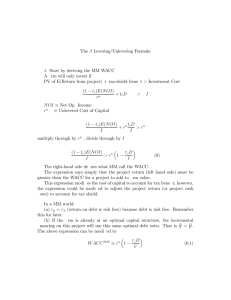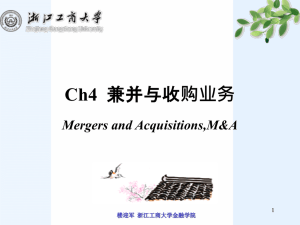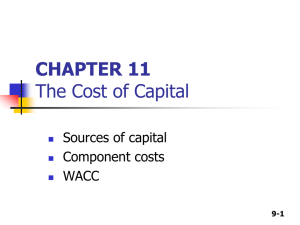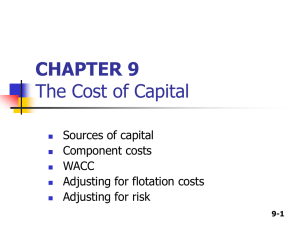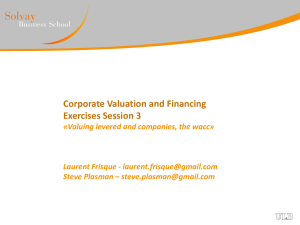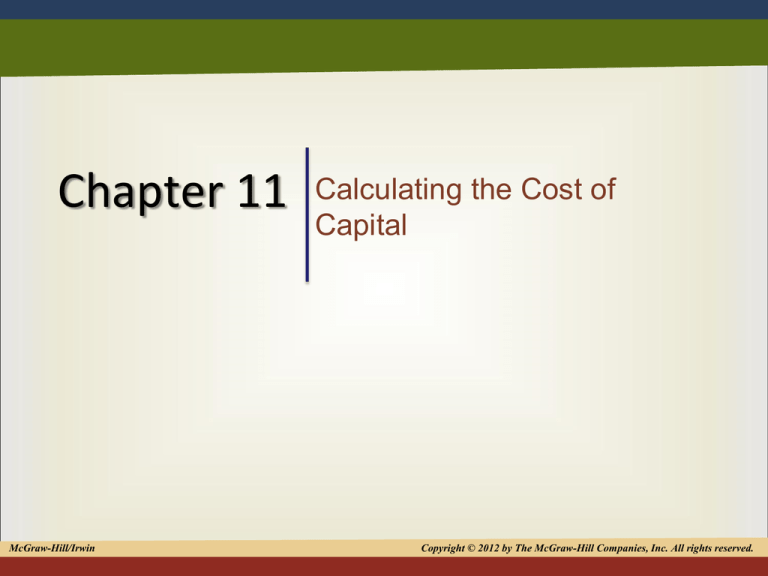
Chapter 11
McGraw-Hill/Irwin
Calculating the Cost of
Capital
Copyright © 2012 by The McGraw-Hill Companies, Inc. All rights reserved.1
The WACC Formula
• Weighted Average Cost of Capital (WACC)
is the average cost per dollar of capital
raised
• Weights are based on market values, not
book values
11-2
WACC
11-3
Component Cost of Equity
• Two ways to calculate
– CAPM
– Constant-growth model
11-4
Component Cost of Equity
and CAPM
• Not appropriate to use when historical data
insufficient or not good indicator of future
• CAPM is generally the more accurate
estimate
11-5
Component Cost of Equity and
Constant-growth Model
• Use when constant dividend growth is
expected on limited number of stocks
11-6
Component Cost of
Preferred Stock
• Calculate with constant-growth model
11-7
Component Cost of Debt
• Two-part calculation
1) Estimate before-tax cost of debt by using
Yield to Maturity
2) Solve for interest rate that makes price
equal to sum of present values for coupons
and face value of bond
11-8
Component Cost of Debt
• Debt is tax deductible
– Two-part calculation adjusts to after-tax rate
of return
11-9
Tax Rates
• Firm’s marginal tax rate affects the benefit of
debt-interest deductibility
• WACC tax rate
– the weighted average of marginal tax rates
on income shielded by interest deduction
11-10
Calculating WACC Weights
• Percentages of funding that come from
– Equity
– Preferred stock
– Debt
11-11
Firm vs. Project WACC
• Firm WACC
– Use for evaluating typical projects
• Project WACC
– Use with atypical projects such as those with
higher or lower risk
11-12
Divisional WACC
• Less time-consuming and uses fewer
resources
• Divides firm’s existing projects into divisions
• WACC based on average project risk in
each division
11-13
Risk-Appropriate WACC
• Sloped line represents return rates and risk
11-14
Risk-Sensitive WACC
Expected returns
are greater than
WACC
Expected returns
are less than
WACC
11-15
Inappropriate use of Firmwide
WACC
Incorrect
Decisions
11-16
Divisional WACC
• Use of divisional WACC reduces errors
11-17
Subjective vs. Objective
• Subjective approach to assessing risk
results in arbitrary adjustments
• Created only for current project
11-18
Subjective vs. Objective
• Objective approach is more precise but
harder to implement
– May use CAPM formula
11-19
Flotation Costs
• Externally-generated capital
– Stock issues
– Bond issues
• Issuing securities generates underwriting
costs such as commissions
11-20
Flotation Costs
• Two ways to account for flotation costs
1) Increase costs as percentage of WACC
2) Adjust initial project investment upwards
11-21




